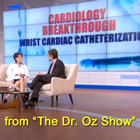Millions of people were exposed to the concept of the radial, (or wrist), approach to angioplasty recently, when the Dr. Oz show featured catheterization via the wrist in its “Dr. Oz’s Ultimate Insider’s Guide: The Newest Medical Breakthroughs.”
This story placement was definitely a win for patients; people are likely to start seeking out the wrist approach as a result of this highly visible coverage. At Angioplasty.Org we’ve been advocating the advantages for patients of this 20-year-old technique of conducting catheter-based heart procedures via wrist rather than the groin – fewer complications, less bleeding and faster recovery — since 2007. Even a brief mention of this technique on a hit TV show reaches a massive number of patients who are not seeking out in-depth reporting at sites like ours, so we’re excited to see the information get out to a larger audience.
The slight downside, of course, is the sensationalizing and de-contextualizing of the concept, which seems to be part and parcel of obtaining media attention. Dr. Oz’s guest Dr. Jennifer Tremmel did a great job of explaining the benefits of the wrist approach and how the procedure is done. But Dr. Oz, in his enthusiasm, swept away the nuances of when and why one would need a catheterization in the first place, and how this “breakthrough” does or does not change heart treatment. Patients might well be mislead by his statement positing the wrist approach as
“…a radical new procedure that can help you find out if you are at risk for heart disease and treat it at the same time.”
Ironically, two years ago Dr. Oz stated that half of all angioplasties done were unnecessary, and he now seems to be advocating Ad Hoc PCI (treating blockages with angioplasty immediately upon diagnosis), which many experts believe to be one of the primary drivers of over-stenting… but more on that subject in another post.
Wrist angioplasty is a relatively new (in the US at least) improved technique (accessing the heart via the wrist) for doing an old thing: cardiac catheterization (taking angiography images of the heart vessels to determine extent of disease and treating blockages via catheters).
Cardiologists have been diagnosing and treating heart disease via catheters for 35 years, and the wrist approach has been the predominant technique in Europe, Japan, etc. for almost a decade. “Wrist catheterization,” as Oz calls it, is a great technical improvement, but not a fundamental breakthrough in the actual treatment and diagnosis of disease. The peculiar thing is that Dr. Oz must understand this difference, of course — as a cardiac surgeon, he’d fully grasp the vocabulary around the procedure, as he’s been looking at patients’ catheterization images for his entire career.
So why not just say, “Hey, here is a better way of getting a cardiac catheterization. And sometimes, when you get that catheterization, you and your cardiologist may choose to go ahead treat your blockages with a stent”?
I would guess that, as an edutainment expert, Dr. Oz also knows that an urgent, breathless story like “New, radical, secret, unknown, exclusive thing! This changes everything, you should get it!!” will grab attention, and will be remembered. It sounds a lot more exciting than explaining “Here is a safer, less invasive option to consider, under specific circumstances, when you and your doctor have determined that a diagnostic cath may be warranted. These choices should be made in the context of being an informed patient who is seeking to understand all the options in managing and treating heart disease and seeking out physicians who offer the most current treatment techniques.”
The more patients that know about this less invasive alternative the better, so the story is still a good thing overall. It’s just that, as an educator, I have to wonder, do patients really require or prefer this hyped up, less nuanced approach? Does it serve them better? It does seem to be what it takes to get big time media coverage. But hey, that’s showbiz.
For a more in-depth understanding of what “wrist catheterization” is, visit our Wrist Angioplasty FAQ and our Transradial Section; to find one of the many cardiologists in the US offering this option, visit our Radial Hospital Locator.
posted by Deborah Shaw, Angioplasty.Org Patient Education Editor


 While medical research continually expands the treatment options that doctors can offer heart disease patients, the adoption of new techniques is not universal. Studies show a wide variation in the tests and treatments that heart patients receive, depending on where they live and who their doctors are.
While medical research continually expands the treatment options that doctors can offer heart disease patients, the adoption of new techniques is not universal. Studies show a wide variation in the tests and treatments that heart patients receive, depending on where they live and who their doctors are. RSS Feed
RSS Feed

 Taking Charge of your Health
Taking Charge of your Health
 How Long will a Stent Last?
How Long will a Stent Last?